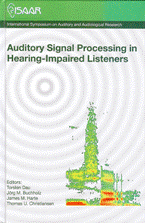Influence of listener task on ratings of pleasantness for everyday sounds
Abstract
Objective: To develop a method to investigate the influence of subject task on the evaluation of sound stimuli. The method is for use in future hearing aid experiments. Method: Twenty listeners with normal hearing rated real-life sound stimuli under different conditions. The sound stimuli were binaurally-recorded soundscapes with low-level target sounds mixed in. The conditions were: 1. Listening only to sound stimuli without any other tasks. This condition is similar to the method used in typical hearing aid studies. 2. An ‘auditory detection’ paradigm, where listeners detect low-level target sounds (e.g. a microwave beep) within the sound stimuli. 3. The ‘irrelevant sound’ paradigm, where listeners perform cognitive tasks (e.g. simple addition of numbers), while the sound stimuli are presented. After listening to each sound stimulus under these three conditions, listeners rated the pleasantness of the sound stimulus. Results and Conclusions: Ratings of auditory pleasantness were lower under the irrelevant sound condition and under the auditory detection condition than in the listening only condition. However, there was a large degree of variability associated with the ratings, which reduces the sensitivity of the method for use of evaluating hearing aid settings.
References
Beaman, C. P. (2005). “Auditory distraction from low-intensity noise: A review of the consequences for learning and workplace environments,” Applied Cognitive Psychology, 19, 1041–1064.
Bjerg, A. P. and Larsen, J. N. (2006). “Recording of natural sounds for hearing aid measurements and fitting,” Masters thesis, Acoustic Technology, Ørsted•DTU, Technical University of Denmark. http://server.oersted.dtu.dk/ftp/tp
Brainard, D. H. (1997). “The psychophysics toolbox,” Spatial Vision, 10, 443–446.
Ellermeier, W., Mader, M., and Daniel, P. (2004). “Scaling the unpleasantness of sounds according to the BTL model: Ratio-scale representation and psychoacoustical analysis,” Acta Acustica United with Acustica, 90,101–107.
Eisenberg, L. S., Dirks, D. D and Gornbein, J. A. (1997). “Subjective judgments of speech clarity measured by paired comparisons and category ratings,” Ear and Hearing, 18, 294-306.
Jones, D. M.; Alford, D.; Macken, W. J.; Banbury, S. P., and Tremblay, S. (2000). “Interference from degraded auditory stimuli: linear effects of changing-state in the irrelevant sequence,” Journal of the Acoustical Society of America, 108, 1082-1088.
Jones, D. M., and Macken, W. J. (1995). “Organizational factors in the effect of irrelevant speech: the role of spatial location and timing,” Memory and Cognition, 23, 192-200.
Neuman, A. C., Bakke, M. H., Mackersie, C., and Hellman, S. (1998). “The effect of compression ratio and release time on the categorical rating of sound quality,” Journal of the Acoustical Society of America, 103, 2273-2281.
Noble, W., and Gatehouse, S. (2004). “Interaural asymmetry of hearing loss, speech, spatial and qualities of hearing scale (SSQ) disabilities, and handicap,” International Journal of Audiology, 43, 100–114.
Thorne, D. R., Genser, S. G., Sing, H. C., and Hegge, F. W. (1985). “The Walter Reed performance assessment battery,” Neurobehaviour, Toxicology and Teratology, 7, 415–418.
Additional Files
Published
How to Cite
Issue
Section
License
Authors who publish with this journal agree to the following terms:
a. Authors retain copyright* and grant the journal right of first publication with the work simultaneously licensed under a Creative Commons Attribution License that allows others to share the work with an acknowledgement of the work's authorship and initial publication in this journal.
b. Authors are able to enter into separate, additional contractual arrangements for the non-exclusive distribution of the journal's published version of the work (e.g., post it to an institutional repository or publish it in a book), with an acknowledgement of its initial publication in this journal.
c. Authors are permitted and encouraged to post their work online (e.g., in institutional repositories or on their website) prior to and during the submission process, as it can lead to productive exchanges, as well as earlier and greater citation of published work (See The Effect of Open Access).
*From the 2017 issue onward. The Danavox Jubilee Foundation owns the copyright of all articles published in the 1969-2015 issues. However, authors are still allowed to share the work with an acknowledgement of the work's authorship and initial publication in this journal.


